Typically, we think of water as clear and without any color. However, Mother Nature always has a few tricks up her sleeve. It turns out that water can come in a whole kaleidoscope of colors, from chocolate brown to ebony black, blood red, cobalt blue, dark green, sparkling turquoise, and even bright bubble-gum pink! Fascinating lakes of nearly every color of the rainbow cover the earth, continually enchanting us with their surprising and breathtaking hues. Let’s take a closer look at 15 of the most uniquely colored lakes in the world.

15. Lake Pukaki (New Zealand)
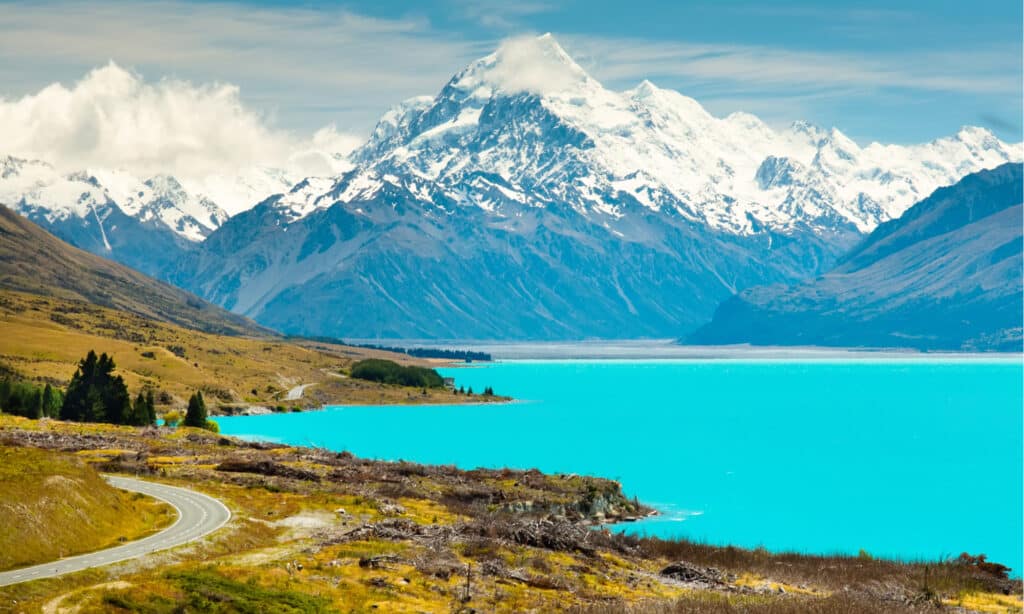
Lake Pukaki is on the northern edge of Mackenzie Basin.
©TDway/Shutterstock.com
Lake Pukaki is an alpine lake on New Zealand’s South Island with dazzling blue water. This vivid blue color comes the “glacier flour” of the Tasman and Hooker Glaciers. Glacier flour comes from bits of rock that have been ground down by erosion into tiny grains, like finely-ground flour. When sunlight hits the water of the lake, it reflects off the tiny glacier flour particles, giving the water a brilliant aquamarine color. Even when you get close to the lake, the vibrant color remains.
You can go swimming in the calm waters of Lake Pukaki. However, it is a glacier lake, so it is very cold! Paddleboarding is another popular activity for those who wish to stay out of the lake’s frigid waters. Framed by New Zealand’s tallest peak, Mount Aoraki / Mount Cook, Lake Pukaki is also a beautifully picturesque setting for photography enthusiasts. The Pukaki Scientific Reserve on the western side of the lake is also home to the Izatha psychra, a nationally endangered species of moth.
14. Plitvice Lakes (Croatia)
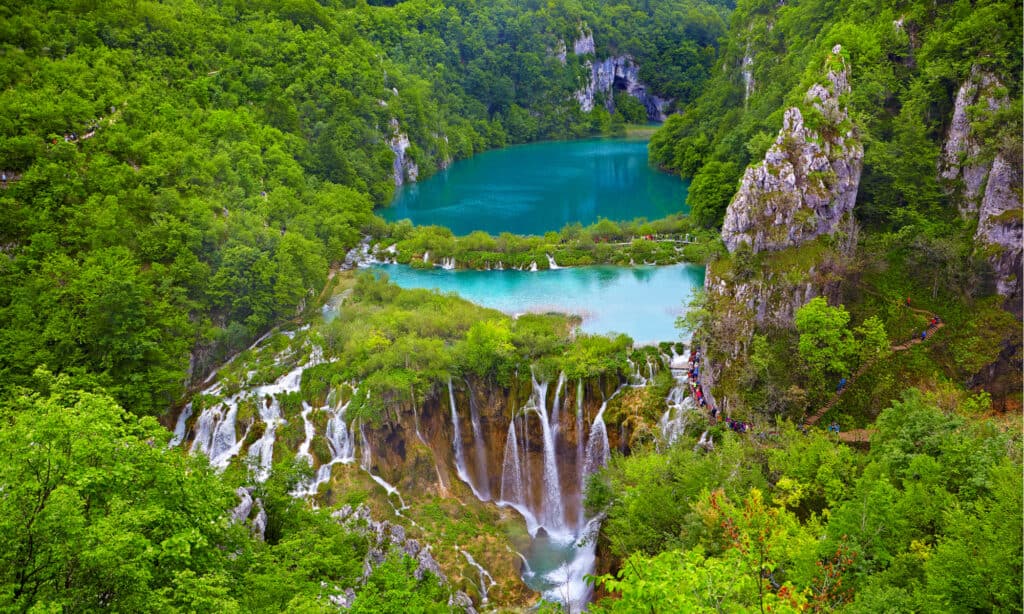
Over one million people visit the Plitvice Lakes every year.
©LeonP/Shutterstock.com
The other-worldly Plitvice Lakes in Croatia are look like something out of a fairytale. There are 16 lakes in total, connected to one another by stunning cascades and waterfalls. The lakes are “tufa” lakes with natural dams, algae, moss, and bacteria. The lakes’ brilliant colors are from sunlight reflecting off the unique limestone mineral deposits and organisms living in the water. The colors of the lakes change depending on the quality and amount of minerals and organisms in each lake, as well as the angle of the sun.
The 16 Lakes of Plitvice Lakes National Park rise and fall at different cascading levels. Each lake is also its own unique shade of gray, blue, and green. For example, the highest lake, Prošćansko, is 2,093 feet above sea level. It is usually a dark green color because it is so wide and deep. On the other hand, the lowest lake, Novakovića Brod, is 1,650 feet above sea level. Novakovića Brod is also one of the smallest and shallowest of the Plitvice Lakes, with a blueish-green color. Impressive mountain ranges and beautiful forests of pine, spruce, fir, and beech trees surround the Plitvice Lakes. There is also an abundance of wildlife, including otters, skunks, bears, wild boars, foxes, and wolves.
13. Lake Baikal (Siberia)
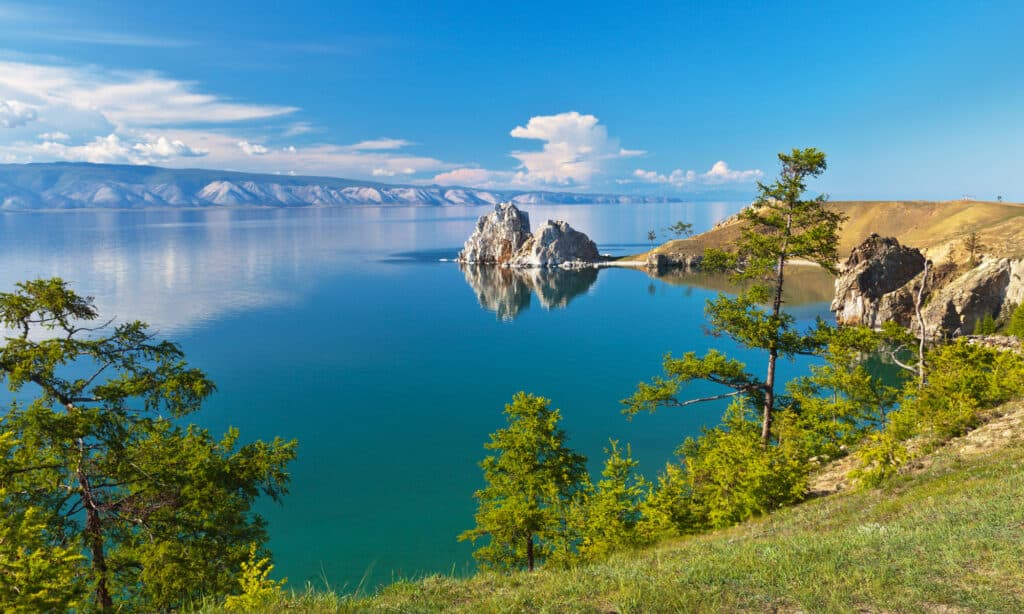
Lake Baikal is the oldest and deepest freshwater lake in the world.
©Katvic/Shutterstock.com
Lake Baikal, or the “Pearl of Siberia,” is one of the most stunning freshwater lakes you may ever see. It is the deepest and oldest freshwater lake in the world, measuring 4,387 feet deep. Lake Baikal is a long crescent-shaped lake with an awe-inspiring backdrop of majestic snowcapped mountains. It is beautiful all year round. However, in the winter the water freezes into glass-like ice that is so clear and transparent that you can see straight into its depths!
Another nickname for Lake Baikal is the “Galapagos of Russia” because of the rich biodiversity in and around the lake. It is home to at least 2,500 different animal species and 1,000 plant species. 80% of the lake’s various species are endemic and can only found in Lake Baikal, like the Baikal seal.
12. Lake Hillier (Australia)

The water of Lake Hillier is bright pink like Pepto-Bismol.
©matteo_it/Shutterstock.com
Lake Hillier’s unique pink color is so bright and bold that it can even be seen by satellites in space! Unlike many other “pink” colored lakes around the world, Lake Hillier stays pink all year long. In fact, even when bottled, the lake’s waters retain their famous bubble-gum pink hue. Lake Hillier is only 1,970 feet long and 820 feet wide, but its bright pink color is hard to miss amid the lush green landscape of paperback and eucalyptus trees.
Scientists are not 100% certain as to why Lake Hillier retains this bright and beautiful pink color. They believe it is likely due to the presence of Dunaliella salina microalgae in the lake’s waters. Dunaliella salina microalgae produce carotenoids, just like carrots do, but instead of orange, these ones make the water pink. The halophilic bacteria in the lake’s salt crust have carotenoids as well, which could also contribute to the pink color. Lake Hillier is a salty lake on very edge of Middle Island, located in the Recherche Archipelago near Australia’s western coast. It is part of a protected reserve, so you can’t visit the lake in person. However, it is clearly seen from above and sometimes from a passing tour boat.
11. Peyto Lake (Canada)

The lake’s beautiful color comes from the glacial rock flour of Peyto Glacier.
©TRphotos/Shutterstock.com
Peyto Lake in Canada is sometimes called the “Bluest Glacier Lake” because of its intensely bright blue color. The lake’s beautiful color comes from the glacial rock flour of Peyto Glacier. From June through September the lake is much fuller from the glacier’s ice melt, with larger amounts of glacier flour in the water to add to its color. From June through October, you can fish on the lake, but be aware that it is “catch and release” only. There are also great trails for hiking during the summer, and skiing and snowboarding in the winter.
10. Laguna Colorada (Bolivia)

Laguna Colorada is only around 9 feet deep.
©Belikova Oksana/Shutterstock.com
Laguna Colorada literally means “Red Lake”. According to legend, this fascinating lake is filled with the blood of the gods, giving the water a deep red color. Considered “Bolivia’s most incredible natural wonder,” Laguna Colorada is located on the Altiplano Plateau of the Andes Mountains, about 14,000 feet above sea level.
This beautiful red lake gets its rich red color from the algae and microorganisms living in its waters, as well as red mineral sediments. These cause the water to shift from deep blue to dark red at various times throughout the year. It is a shallow saltwater lake, with large borax deposits that create miniature white islands along the water’s surface. Laguna Colorada is one of two uniquely colored lakes in the Eduardo Avaroa National Reserve of Andean Fauna. This is a protected area where three near-threatened and endangered species of flamingos come to feast on the lake’s tiny water-dwelling plankton: the Chilean flamingo, the Andean flamingo, and the James’s flamingo. The largest population of James’s flamingo in the world can be found in Laguna Colorada, particularly during the summer months.
9. Laguna Verde (Bolivia)

Laguna Verde is about 14,000 feet above sea level.
©iStock.com/reisegraf
Laguna Verde, or the “Green Lake,” is the complementary opposite of Laguna Colorada. This saltwater lake is also located in the Eduardo Avaroa National Reserve of Andean Fauna, about 55 miles from Laguna Colorada. The waters of Laguna Verde are full of metals and minerals, giving it its namesake green coloring. When powerful winds disrupt the water, the lake shifts from dark emerald green to bright turquoise green.
Laguna Verde lies at the bottom of the Lincancabur Volcano. You can hike to the top of the volcano to see ancient Incan ruins as well as an amazing view of the lake. The Chilean, Andean, and James’s flamingos also live at Laguna Verde during the summer months. The flamingo’s vibrant pink plumage provides a stunning contrast to the lake’s intense green waters.
8. Emerald Lakes (New Zealand)

The Emerald Lakes in New Zealand are on the Tongariro Alpine Crossing, one of the county’s hikes.
©Christina Fink/Shutterstock.com
The Emerald Lakes in New Zealand’s Tongariro National Park are the result of volcanic eruptions more than 275,000 years ago. Snow and ice melt mixed with mineral deposits filled the volcanic craters over time, forming these beautiful lakes. In Maori these lakes are called “Ngarotopounamu,” which means “greenstone-hued lakes”. The water of the Emerald Lakes is very acidic and cold, with minerals like calcium carbonate and limestone that leach from surrounding rocks. These volcanic minerals give the lake its shimmering emerald green color. They also contribute to a heavy sulfuric smell, along with the thermal steam vents surrounding the lake.
7. Okama Crater Lake (Japan)
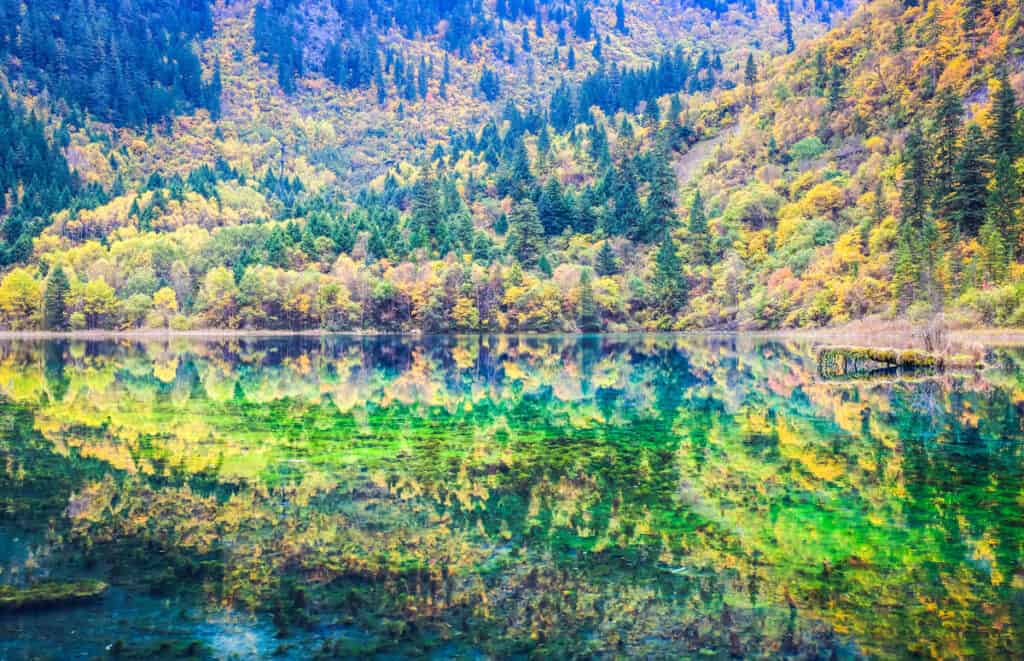
Nothing lives in Okama Crater Lake because the water is very acidic.
©chuyuss/Shutterstock.com
The Okama Crater Lake on Mount Zao was originally created in the 1800’s when the Mount Bandai volcano erupted in the Tohoku region of Japan. Another name for this lake is the “Lake of Five Colors” due to the waters’ spectacular kaleidoscope of fluctuating colors. The color of the water changes throughout the day depending on sunlight and weather, shifting from turquoise to bright blue or dark green.
“Okama” is Japanese for “pot,” referring to the shape of the lake. Okama Crater lake is round like a cooking pot with a circumference of 3,543 feet. The lake is not accessible in the winter because of the ice and snow. However, it is a great place to visit in the summer, and in the fall when the lake is elegantly framed by the changing colors of the trees.
6. Crater Lake (United States)
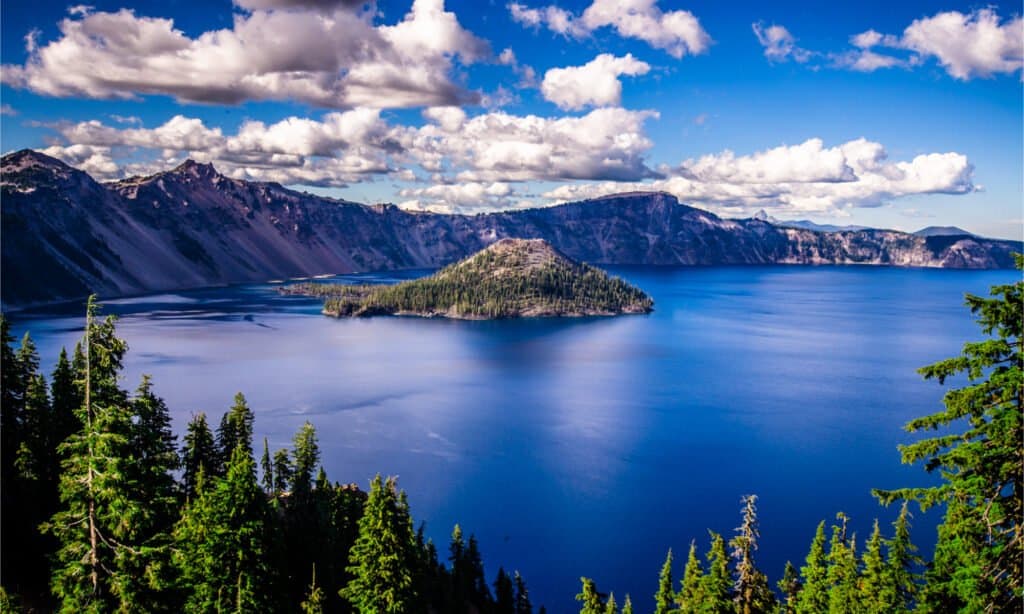
Crater Lake is also known by its nickname, “Lake Majesty.”
©Pung/Shutterstock.com
Oregon’s Crater Lake is the deepest lake in the United States and the 9th deepest lake in the world. This lake is an astounding 1,943 feet deep! It also has some of the clearest waters of any lake on earth. This is because the lake’s supply comes entirely from snow and rainfall, so there are no minerals or sediments in its waters. The depth and clarity of its pristine waters give Crater Lake a deep and pure cobalt blue color.
There are areas where visitors can swim in the lake, but beware, the water is beautiful but very cold! There are also many places for cycling, hiking, skiing, and snowshoeing all around Crater Lake and the Cascade Mountain Range.
According to legend, Crater Lake was formed during a volcanic eruption when the sky spirit defeated the sacred spirit of Mount Mazama in an epic battle, causing the mountain to collapse. There are still many volcanic remains that now form some very interestingly shaped islands within the lake. The largest is “Wizard Island,” which extends nearly 750 feet above the surface of the water! Visitors can travel to the island and even hike its scraggly peaks. Crater Lake is also the only place in the world where the Mazama newt (or Crater Lake newt) is found.
5. Lake Retba (Senegal)

Roughly 45,000 tons of salt is harvested from Lake Retba each year.
©Curioso.Photography/Shutterstock.com
Lake Retba is on the coast of Cape Vert Peninsula, only 20 miles from Senegal’s capital city of Dakar. In Senegal the lake is often referred to as “Lac Rose,” which is French for “Pink Lake.” Lake Retba was once a cove in the Atlantic Ocean. Over time, however, it was cut off from the ocean, becoming an independent saltwater lake. The salt levels in this lake are higher than the Dead Sea, and at times they can reach as high as 40%!
The high concentration of salt in Lake Retba attracts the Dunaliella salina microalgae, coloring the lake pink and red. During the dry season (November through June), the water evaporates, leaving behind higher levels of salt in the remaining water. The large amounts of salt cause the Dunaliella salina microalgae to increase, turning the water blood red. On the other hand, when the water levels are higher and the salt content is lower, the lake is pink.
The water in Lake Retba is safe and you can go swimming here. In fact, there are nearly 1,000 workers in the lake each day collecting salt. Swimming in Lake Retba is an extremely unique experience. The high levels of salt in the water gives it unusual buoyancy. This means you can float in the water without the heavy pull of gravity!
4. Lake Kaindy (Kazakhstan)

Lake Kaindy is about 80 miles east of Almaty, the largest city in Kazakhstan.
©iStock.com/Ozbalci
Lake Kaindy in Kazakhstan’s Kolsay Lakes National Park is both eerie and beautiful. In 1911 the Kebin earthquake in the Tian Shan Mountains triggered a limestone landslide that blocked the gorge, forming a natural dam. The blocked off area filled with rain and mountain river water, drowning a forest of Asian spruce trees with a newly formed lake.
Although the flood waters killed the trees, their trunks remain perfectly preserved by the lake’s freezing cold water. When you get close to the lake, the water is crystal clear so that you can see underneath the water’s surface, where the trees remain frozen in time. The upper sections of the trees protrude above the surface of the lake. They have turned white and lost their branches, causing them to look like ethereal sentinels in the lake’s “sunken forest.”
The water of Lake Kaindy only adds to the beautifully phantasmagorical setting. The lake is 1,300 feet long and 98 feet deep. Limestone deposits in the lake’s waters give it a striking and vibrant blue-green hue. The whitewashed sunken forest, dazzling aquamarine water, and rocky surroundings give Lake Kaindy a supernatural atmosphere of wonder and mystery. In the winter the lake freezes over, and visitors can participate in trout fishing and ice diving.
3. Jellyfish Lake (Palau)
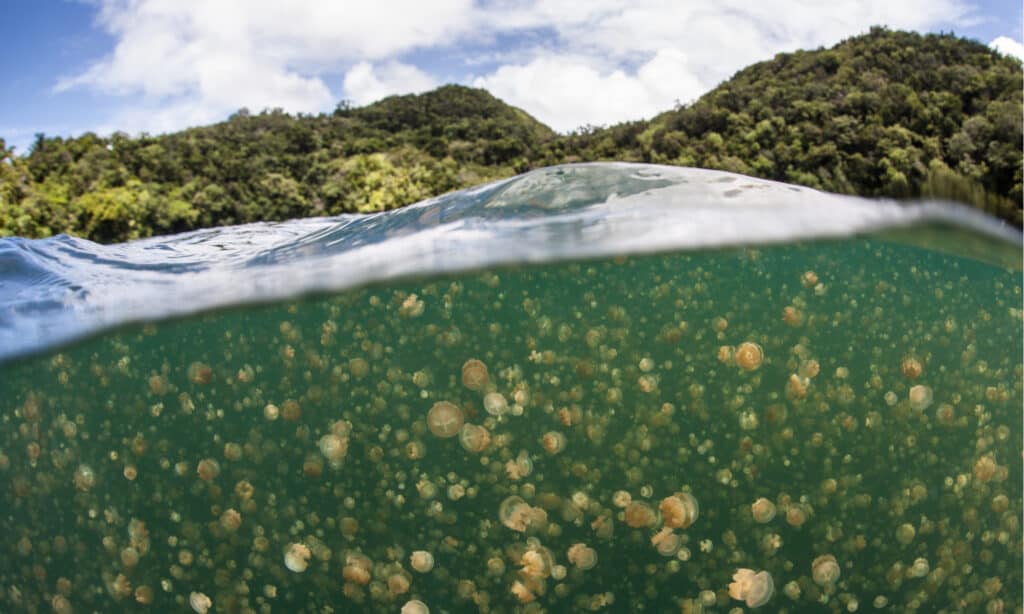
On a typical day, there are around five million golden
jellyfish
in Jellyfish Lake.
©Ethan Daniels/Shutterstock.com
Jellyfish Lake a beautiful marine lagoon in the middle of Palau, surrounded by mangrove trees. It is a stratified, meromictic marine lake. This means that its waters have separate layers that never mix together, each with a different temperature. The lake itself is 1,510 feet long and 520 wide, with an average depth of around 100 feet. Jellyfish Lake offers a picturesque view from its shores, but the truly magical phenomenon of the lake is just below its surface. Within the waters of Jellyfish Lake are millions of sparkling golden jellyfish.
The unique jellyfish subspecies Mastigias papua etpisoni migrates across Jellyfish Lake every single day, providing a truly remarkable display as they twirl about in the sunlit waters. The isolated lake is 12,000 years old, so the jellyfish have gone through a unique evolution. They have very mild stingers that they use to capture the tiny zooplankton organisms in the lake. These jellies are generally harmless to humans, and in fact, most humans may not even feel their sting! When the sun rises in the morning, the jellyfish gather and swim east toward the light. As the sun moves across the sky, the jellyfish turn once again and swim westward toward the setting sun.
2. Lake Khiluk or the “Spotted Lake” (Canada)
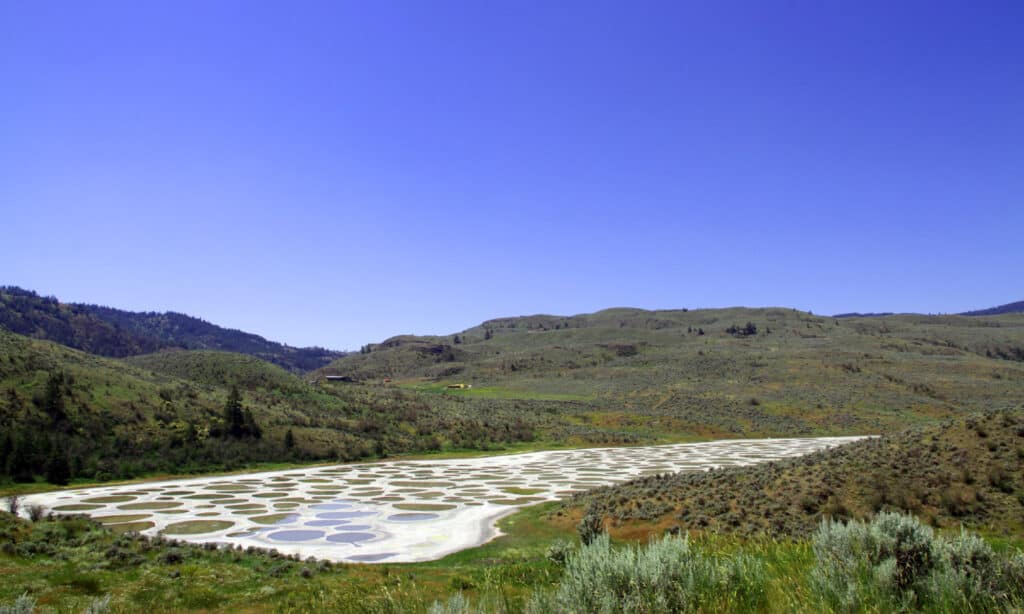
Salt and various minerals were mined from Lake Khiluk during World War I.
©iStock.com/BrendanHunter
Lake Khiluk in British Columbia’s Similkameen Valley is one of the most unique lakes in the world. During the spring and winter months, it looks like any other ordinary lake in Canada. However, Lake Khiluk has a lot of minerals like sodium sulphates, epsom salts, calcium, and magnesium sulphates. When temperatures rise in the summertime, the water of the lake evaporates. This leaves behind hundreds of smaller “spotted” lakes of blue, green, and yellow. The colors and sizes of the small pools change throughout the summer, depending on the amount and concentrations of minerals in the water.
This magical “Spotted Lake” is found along Highway 3, northwest of Osoyoos. However, it is a very sacred place for the Syilx people of the Okanagan Nation. They believe that each briny pool holds a different healing property. In 2001 the Okanagan Nation Alliance Chiefs Executive Council purchased the land surrounding the lake. Today Lake Khiluk is restricted from public access. However, you can still get a spectacular view of the lake from the highway.
1. Kelimutu Lakes (Indonesia)
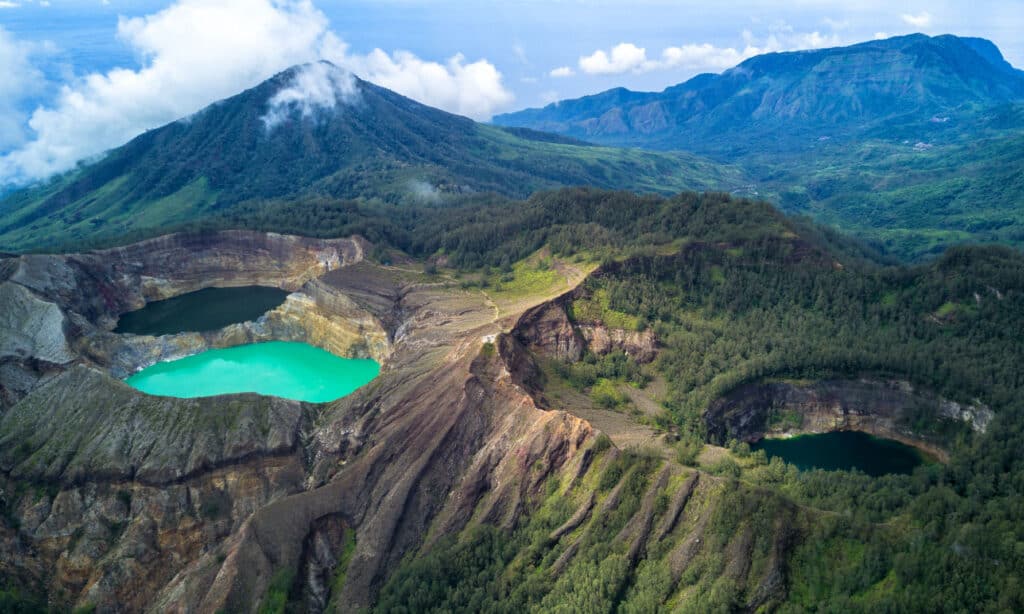
The colors of the Kelimutu Lakes are unpredictable.
©Muhammad Nurudin/Shutterstock.com
Each lake atop the Kelimutu Volcano is a different color. Astonishingly, these lakes spontaneously change colors, and no two lakes are ever the same color at the same time. Scientists believe that the colored water comes from chemical changes of the lake’s volcanic minerals. It could also be from underwater fumaroles in the lakes, which are natural vents in the earth’s surface that emit hot gasses. Sometimes the lakes are black, blue, and green, but later they may change to blue, red, and white. Most commonly, the three lakes are blue, green, and red.
Locals believe that the Kelimutu Lakes serve as the final resting place for departed souls. Tiwu Ata Mbupu, or the “Lake of Old People,” is the resting place for those who died in their elder years. This lake is often blue, but whenever the lake changes color locals give offerings for the dead spirits. The second lake, Tiwu Nuwa Muri Koo Fair, or the “Lake of Young Men and Maidens,” is for souls who died in their youth. The last lake, Tiwu Ata Polo, or the “Enchanted” or “Bewitched Lake,” is the gathering place of souls who were evil or committed many crimes during their mortal lives.
The name “Kelimutu” translates to “the boiling lake”. These volcanic crater lakes are so hot that the steam coming off them is quite dangerous. Visitors can only walk around the lakes from a safe distance. The best time to visit Mount Kelimutu National Park is during Indonesia’s dry season, from May through September. When you visit, be sure to look out for the furry guardian monkeys that often congregate in nearby trees.
Summary of 15 of the Most Uniquely Colored Lakes in the World
| Rank | Lake | Unique Feature |
|---|---|---|
| 15 | Lake Pukaki (New Zealand) | A vivid blue color owing to glacier flour from the Tasman and Hooker Glaciers |
| 14 | Plitvice Lakes (Croatia) | Brilliant colors owing to sunlight reflecting off mineral deposits and organisms in the water |
| 13 | Lake Baikal (Siberia) | A surface which freezes in winter but remains transparent along with its depths |
| 12 | Lake Hillier (Australia) | Bright pink coloring that can be seen by satellites from space |
| 11 | Peyto Lake (Canada) | Intense bright blue coloring owing to glacial rock flour from Peyto Glacier |
| 10 | Laguna Colorada (Bolivia) | A rich red hue owing to the presence of algae, mineral sediment, and microorganisms The largest population of James’ flamingos |
| 9 | Laguna Verde (Bolivia) | A high mineral and metal content resulting in green coloring. The presence of Chilean, Andean, and James’s flamingos in summer |
| 8 | Emerald Lakes (New Zealand) | Lakes with water which is an emerald green color owing to a high volcanic mineral content |
| 7 | Okama Crater Lake (Japan) | Waters of high acidity which change color depending on the the sunlight and the weather |
| 6 | Crater Lake (United States) | A depth of almost 2,000 feet, cold pristine waters in a deep cobalt blue free of any sediment or minerals |
| 5 | Lake Retba (Senegal) | A high salt concentration of salt which attracts the Dunaliella salina microalgae, coloring the lake pink and red |
| 4 | Lake Kaindy (Kazakhstan) | A perfectly preserved underwater forest of Asian spruce beneath a crystal clear surface |
| 3 | Jellyfish Lake (Palau) | A meromictic marine lake with millions of sparkling golden jellyfish |
| 2 | Lake Khiluk or the “Spotted Lake” (Canada) | Spotted lakes of blue, green, and yellow which appear in summer and change according to their mineral content |
| 1 | Kelimutu Lakes (Indonesia) | Different colored lakes which are never the same color at the same time |
The photo featured at the top of this post is © Christina Fink/Shutterstock.com
Thank you for reading! Have some feedback for us? Contact the AZ Animals editorial team.







